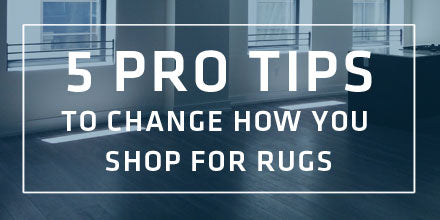- Continue Shopping
- Your Cart is Empty
5 Pro Tips to Change How You Shop for Rugs

Friends and family are always asking us what they really need to know when buying rugs, and here, we're sharing our insights with you. Without further ado, the 5 things anyone shopping for a rug should know:
#1 The right size rug will make/break your room
Determining the size of rug you need for the effect you want to achieve should be step #1. There’s not an exact science to picking the right size to a room, but there are some specific guidelines you need to follow to get the effect you want. If you want a piece that spices up a corner, but doesn’t take over the room, it needs to be small in relation to other elements. If you want an expansive, light feeling, you need a light-colored rug that sits completely underneath every piece of furniture, ideally with a perimeter of at least 6 inches. For more help on this, check out our Cheat Sheet.
#2 Rugs are priced by size
It often seems that rugs are priced as round numbers —$2,000 for a 6x9, for example — but really, the price of a rug is driven by the value per square-foot. This value is determined by the quality of the materials, the complexity of the design, the length of production time, and where the rug is produced — the larger the rug, the more materials, time and effort placed into producing it. Hence, the higher price.
Why is this important? A lot of times, people start searching for a rug thinking, “I need a living room rug for $XX ” —and if rugs they like are higher than their budget, they start considering smaller rugs to reduce the price. This is not the approach we recommend.
You’re still spending a good amount of money, but not getting the effect you want out of the room. It’s really about getting the right size. If the prices seem out of reach, consider a design that is simpler or a rug that takes less time to produce.
#3 Do NOT buy a rug for its future value…
…Buy it for its longevity. Sometimes, people will buy a rug because they believe it is a rare or valuable piece and could be worth more money in the future. A rug is an investment — for your home. It is helpful to think of it as the same kind of investment you make in a fine quality couch or dining table—a good piece saves you from replacing it over and over.
While it is true that there are rugs that will become valuable 10, 20, 30 years down the line, this is difficult to gauge and to assign an actual value, since there are a number of factors that will influence it. Instead, think of it as a purchase that saves you money by lasting a lifetime, keeping you from replacing a deteriorating product frequently.
If you are interested in rugs for their investment quality and antique value, be sure to spend some time researching the rug style and make sure you buy from a trusted seller.
#4 Material is really, really important
It’s really easy to disregard the material of a rug since we are all almost always shopping based on look and cost (and hopefully size!). But the material you choose will have a big impact on how the rug holds up over time, and even how it looks in your space.
Natural fibers like wool, cotton, sisal, jute and silk have long lifespans and can be cleaned (sometimes professionally, in the case of bad spills). The better the quality of these materials, the higher the price — but this also correlates to a longer lifespan for the rug. Getting a rug that doesn’t need to be replaced often can save you a lot of money over time.
Synthetic materials like petroleum-based polyester and polypropylene have advanced considerably in their look and texture, but still don’t have the longevity of hand-knotted or hand-woven rugs. They typically last 1-2 years — part of which is due to the material, and part of which is due to the make….
#5 Make is really, really important
Make is how the rug was actually produced: Made by hand, such as hand-knotted and hand-woven OR manufactured with modern techniques, like machine-made and hand-tufted.
Hand-made rugs are crafted from techniques that give structural integrity to pieces: Hand-knotted rugs are made from hundreds of thousands, if not millions, of threads knotted to the rug’s cotton or wool foundation. Hand-woven rugs are made by repeatedly passing a warp through the carpet’s weft. These techniques insure that every part of the rug is integral to the rug’s structure, and therefore, less likely to come apart.
More modern techniques are more about assembling pieces quickly than weaving strong, durable rugs. For example, in hand-tufting, a tufting gun is used to shoot fabric “tufts” through a plastic grid. These rugs need to be backed with a polymer or glue to keep the tufts in place. Not only is the wool of lesser quality, the backing material can deteriorate and both the backing and pile will begin to shed. Machine-made rugs are made at incredible speed on a machine similar to a newspaper ream, and usually from polymer-based materials to survive this process. These synthetic materials breakdown as would other petroleum based materials.
Sometimes, labeling can be confusing, just generally describing a rug as “hand-made” — when really what they mean is “hand-tufted.” If you’re not sure, look at the back of the rug. If the design on the front is not visible on the back, it wasn’t really made by hand.
SO that’s it for now! To learn more or to be alerted when we post additional insights, follow us on Twitter, Facebook or Pinterest.






Erin Eisinger
Author
Floorplan CEO and Co-Founder. Designer. Storyteller. Entrepreneur.